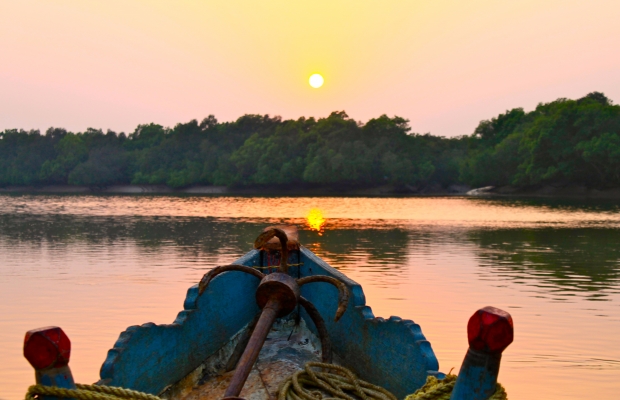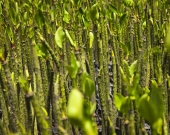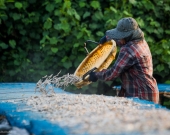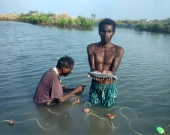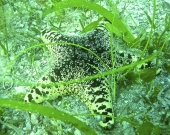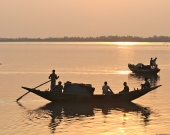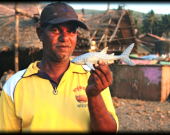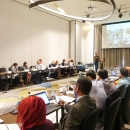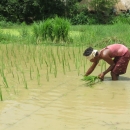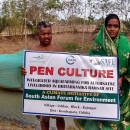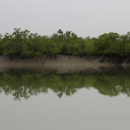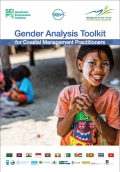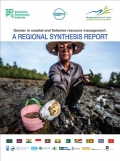MFF in India primary focus is on improving the scientific knowledge base to feed into national policies for enhanced management of coastal and marine ecosystems. National and regional symposia supported by MFF have greatly contributed to this by establishing baseline database for coastal and marine ecosystems (specifically mangroves and coral reefs). Information sharing with civil societies is also helping to raise awareness about India’s valuable coastal resources.
Other MFF priorities in India are to promote environmentally sustainable livelihood opportunities for coastal communities, and to build resilience to climate change and natural disasters through community participation for greater coastal area decision making and disaster risk reduction planning.
Surrounded by the Indian Ocean, the Arabian Sea and the Bay of Bengal, India has over 7,500 kilometers of coastline that spans 13 maritime mainland States and Union Territories (UTs). India is home to a variety of coastal and marine ecosystems that are storehouses for biodiversity. From an economic perspective, these coastal and marine ecosystems are of great importance in that they provide a wide range of ecosystem goods and services. Approximately 20 percent of India’s population lives in coastal areas, with a large proportion based in coastal urban centers like Mumbai, Chennai and Kolkata. For those who live along the coastal belts, the fisheries sector are vital providing employment to over 6 million people and accounts for 1.07% of India’s total GDP.
Rapidly increasing development has put numerous direct and indirect pressures on coastal ecosystems in the form of degradation and destruction. Climate Change is likely to further exasperate the loss of biodiversity. With increases in extreme weather events, sea-level rise, warming of the sea surface temperatures and ocean acidification social, economic and environmental problems will be faced by the people of India.
The Government of India has recognized that the long-term solution to coastal and marine ecosystem degradation requires a holistic and integrated approach. One that promotes multi-sector coordination to integrate environmental management principles, such as biodiversity conservation objectives, into economic production activities is necessary. Similarly, ensuring compliance with existing laws and regulations requires a coordinated response from a number of sectors.
Climate Change
Climate change is likely to have a considerable impact on coastal and marine ecosystems, including an increase in extreme weather events, as well as sea level rise, warming of the sea surface temperatures and ocean acidification. Climate change issues have been incorporated into the priorities of the Indian NSAP, with climate change considerations featured as a key criterion in the selection of MFF India Large Project.
MFF’s Programme of Work in India
Comprised of a range of governmental departments, NGOs, intergovernmental organizations and academic institutions, MFF’s programme of work in India is overseen by a National Coordination Body (NCB). The National Strategy and Action Plan (NSAP) guides the work of the NCB. Details of India’s programme of work can be found in the revised draft NSAP, which is implemented with the support and active participation of the Ministry of Environment and Forests (MoEF), Government of India.
Geographic Focus
MFF in India works at the national level by networking, influencing policy issues, conducting training missions and through regional coordination activities. At the local level community networking, experience sharing and site-specific actions are at the core of MFF’s activities.
For execution of MFF projects, five States in India were identified as priority areas. Selection of the five States was accomplished with seven categories in mind, which include: human pressure, pollution, degradation, cyclone, climate change and sea level rise, seascape setting and unique features. The selection was largely guided by the following three measures:
- Large extent of mangroves (West Bengal and Gujarat)
- Biodiversity richness of mangroves (Orissa and West Bengal)
- Tsunami-affected mangroves (Andhra and Tamil Nadu)
Country strategy
The National Strategy and Action Plan (NSAP) is organised into two cateogires; Conservation Stratefy and Action Plan for mangroves and Resotration Strategy and Action Plan for potential and/or degraded mangrove areas. Under India's NSAP, four priority areas have been identified in relation to the MFF PoWs:
- Environmentally sustainable livelihoods to reduce pressure on coastal ecosystems (PoWs: 8.1, 8.3, 8.4 & 8.5)
- Plantation of mangroves for creating green belts (PoW 9.3)
- Civil society awareness, participation and coastal decision making and sustainable financing (PoWs: 6.1, 6.2, 6.4, 6.6, 10.3, 11.1)
- Improving knowledge gaps (PoW 1.1)
Alignment to on-going country intiatives and priorities
At the national level MFF goals and priorities align with the following:- Supporting national legislation: Indian Forest Act, 1882; Wildlife (Protection) Act, 1972; Forest Conservation Act, 1980; Environment Protection Act, 1986; Coastal Regulation Zone (CRZ) Notification, 1991 under the Environment Protection Act, 1986; Biological Diversity Act, 2002
- Special National Acts: Karnataka Tree Act; and Tamil Nadu Hill Preservation Act
- Relevant national policies: National Forest Policy 1988; India’s National Environment Policy (NEP)
- Under the system of democratic decentralization of responsibilities enshrined in Constitution amendment No. 73 of 1993, local bodies consisting of elected representatives, one third of whom are women, have been entrusted with the responsibility of safeguarding the local environmental capital stocks.
 India
India 